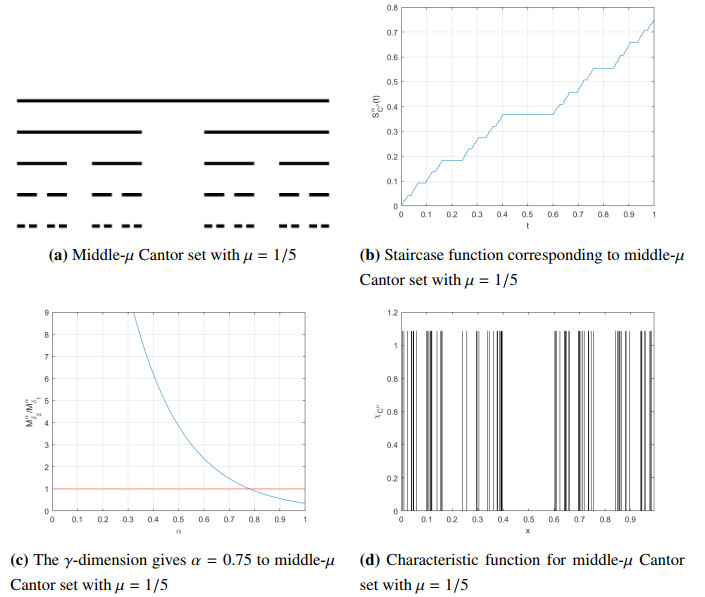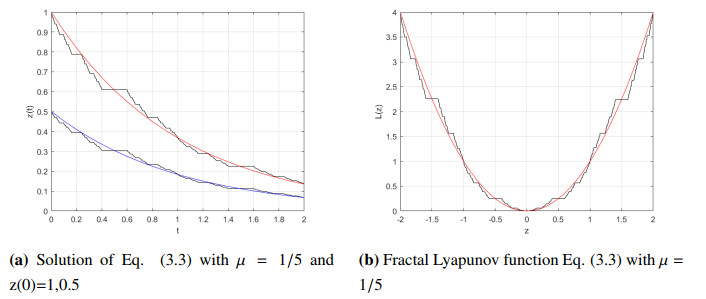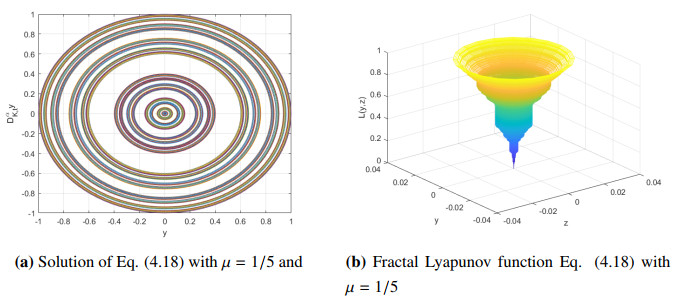In this paper, we give a review of fractal calculus which is an expansion of standard calculus. Fractal calculus is applied for functions that are not differentiable or integrable on totally disconnected fractal sets such as middle-μ Cantor sets. Analogues of the Lyapunov functions and their features are given for asymptotic behaviors of fractal differential equations. The stability of fractal differentials in the sense of Lyapunov is defined. For the suggested fractal differential equations, sufficient conditions for the stability and uniform boundedness and convergence of the solutions are presented and proved. We present examples and graphs for more details of the results.
1.
Introduction
The main purpose of this note is to provide an alternative construction of nonnegative and nonradially symmetric initial data for some Keller–Segel-type models which will enforce finite or infinite blowup. Consider the following functional:
where Ω⊂R2 is a bounded domain with C2 boundary ∂Ω and a pair of nonnegative smooth functions (u,v). The main result of this note is stated as follows.
Theorem 1.1. For any M>0 and Λ∈(4π,∞) there exists a pair of nonnegative functions (u0,v0)∈(C∞(¯Ω))2 satisfying
The above functional F(u,v) appears in the study of the minimal Keller–Segel system:
and also one of the following chemotaxis model featuring a signal-dependent motility function of the negative exponential type:
Classical positive solutions of (1.1) satisfy the following energy-dissipation identity ([4,9]):
while for the classical solutions to (1.2), there holds ([2]):
In both cases, the above energy identities will immediately give rise to the a priori upper bound for F(u,v)(t). On the other hand, for any given initial data of small total mass such that ‖u0‖L1(Ω)<4π, one could derive a lower bound for the energy functional and then the classical solutions of both systems (1.1) and (1.2) exist globally in time and remain bounded uniformly in the two-dimensional setting (see [2,4,7,9]). For large data, unbounded solutions of the above problems could be constructed based on observations of the variational structure of the stationary problem and by taking an advantage of the subtle connection between its associated functional with the energy F. In [5] the authors introduced a transformation problem of the original system (1.1) with the unknowns being the cell density and the relative signal concentration. Then they constructed unbounded solutions for the transformed problem, which in turn implied blowup of the original one.
In this note we would rather to construct an unbounded solution to the original system (1.1) or (1.2) in a more direct way. To this aim, let us sketch the main idea of the construction of an unbounded solution following [11] (see also [5]). First, the corresponding stationary solutions (us,vs) to (1.1) or (1.2) satisfy the following problem:
for some Λ>0. Denote
for Λ>0. By [5,Lemma 3.5] and [10,Theorem 1], for Λ∉4πN there exists some C>0 such that
and
On the other hand, let (u,v) be the classical positive solution to (1.1) or (1.2) in Ω×(0,∞). If the solution is uniform-in-time bounded, by the compactness method (cf. [13,Lemma 3.1]), there exist a sequence of time {tk}⊂(0,∞) and a solution (us,vs) to (1.3) with Λ=‖u0‖L1(Ω) such that limk→∞tk=∞ and that
as well as
Thus taking account of the above discussion, for a pair of nonnegative functions (u0,v0) satisfying
the corresponding solution must be unbounded or blow up in finite time.
Recently in [2], we constructed nonnegative initial data satisfying (1.4) when Λ∈(8π,∞) in the radially symmetric case, which differs from those given in [5]. However, it was left open whether our idea for a construction of adequate initial data can be extended to the nonradial symmetric case if Λ∈(4π,8π). Theorem 1.1 of the present work gives an affirmative answer to this question and as a consequence, we have an alternative proof of the following corollaries ([5]).
Corollary 1.2. For any Λ∈(4π,∞)∖4πN there exists a nonnegative initial datum (u0,v0) satisfying (1.4) such that the corresponding classical solution of (1.1) satisfies either:
● exists globally in time and lim supt→∞(‖u(t)‖L∞(Ω)+‖v(t)‖L∞(Ω))=∞;
● blows up in finite time.
Remark 1.3. Finite time blowup solutions of the corresponding parabolic-elliptic system are constructed if Λ>4π in [8].
As to the system (1.2), global existence of classical solutions with any nonnegative initial data was guaranteed in [2], which excluded the possibility of finite-time blowup. Hence, we arrive at the following:
Corollary 1.4. For any Λ∈(4π,∞)∖4πN there exists a nonnegative initial datum (u0,v0) satisfying (1.4) such that the corresponding global classical solution of (1.2) blows up at time infinity.
In previous works [3,6,12,13], nonnegative initial data with large negative energy were constructed in several modified situations, e.g., the higher dimensional setting, the nonlinear diffusion case, the nonlinear sensitivity case and the indirect signal case. In those works, the initial datum has a concentration at an interior point of Ω. Similarly, in our precedent work [2], we constructed an initial datum which concentrates at the origin based on certain perturbation of the rescaled explicit solutions to the elliptic system
provided that the total mass Λ>8π. However, without the radially symmetric requirement and when 4π<Λ<8π, we need to construct an initial datum that concentrates at a boundary point. To this aim, some cut-off and folding-up techniques are introduced. Besides, a lemma of analysis (Lemma 2.2) plays a crucial role in estimating the value of each individual integral in the energy functional and in order to get vanishing estimations of the error terms, the radius of the cut-off function used in our case needs to depend on the rescaled parameter as well, which in contrast was fixed in the radially symmetric case in [2].
2.
Proof of Theorem 1.1
A straightforward calculation leads us to the following lemma.
Lemma 2.1. For any λ≥1 and r∈(0,1), the functions
satisfy
Since ∂Ω is C2 class, for any boundary point P∈∂Ω there exist some R′=R′P∈(0,1) and some C2 function γP:R→R such that
(cf. [1,Appendix C.1]). Moreover since Ω is a bounded domain, we can find some point P0=(P1,P2)∈∂Ω satisfying that there exists R∈(0,R′) such that
By translation, we may assume P0=(0,0). Hereafter we fix the above R∈(0,1) and γ=γP0. In this setting, we have the following lemma:
Lemma 2.2. Let f:R2→R be a radially symmetric, nonnegative and continuous function. For any r∈(0,R) it follows that
where
Proof. We first note that for any r∈(0,R),
Since γ(0)=0 and the assumption (2.1), it follows by Taylor's theorem that for all x1∈(−R,R) we have
where K(R):=max|ξ|≤Rγ′′(ξ)>0. Thus we can deduce that
where
By denoting
we confirm that
Since the radial symmetry of f implies
we have
Since
we have that
which concludes the proof.
For any 0<η1<η2 we can construct a radially symmetric function ϕη2,η1∈C∞(R2) satisfying
For any λ>max{1,(4R)65}, we fix
and then 0<r1<r<min{1,R4}. Noting that
and by the increasing property of f, we can find λ∗>max{1,(4R)65} such that
where K(R) is defined in (2.2). Here we confirm that for any λ>λ∗,
Now we define the pair
with some a>0. Here we remark that u0 and v0 are nonnegative functions belonging to C∞(¯Ω).
Lemma 2.3. Let Λ∈(4π,∞). For λ>λ∗ there exists
such that
Proof. Firstly by changing variables, we see that
and that
Here in light of the radial symmetry of uλϕr,r1, we can invoke Lemma 2.2 to have
where we used
By the choice of r>0, we have
Therefore for any λ>λ∗ we find some a=a(λ) satisfying
and (2.4). We conclude the proof.
Lemma 2.4. There exists C>0 such that for all λ>λ∗,
where a=a(λ) is defined in Lemma 2.3.
Proof. Since slogs≤tlogt+1e for s≤t and u0≤auλχBr(0)∩Ω, it follows
Since loguλ≤log(8λ2)=2logλ+log8 and ∫Ωuλ≤8π, we have
By Lemma 2.2 we obtain
Therefore
where we remark that the constant C is independent of a and λ in view of (2.3). We conclude the proof.
Lemma 2.5. There exists C>0 such that for all λ>λ∗,
where a=a(λ) is defined in Lemma 2.3.
Proof. Using vλ>0 in B(0,r), u0=0 on B(0,r)c and r1<R4, we see that
Since uλvλ is radially symmetric and
we apply Lemma 2.2 and recall r1=2−1λ−56 to deduce that
Since
we have that
By (2.5), it follows
On the other hand, by (2.3) and direct calculations we see
Combining above estimates, we obtain that
for λ>λ∗ with some positive constant C, which is independent of a and λ due to (2.3).
Lemma 2.6. For any ε1>0 there exists C(ε1)>0 such that for all λ>λ∗,
where a=a(λ) is defined in Lemma 2.3.
Proof. Since
we see that for λ>1
Hence it follows from straightforward calculations that there is a positive constant C satisfying
where the constant C is independent of a and λ due to (2.3).
Moreover by Young's inequality, for any ε1>0 there exists C′(ε1)>0 such that
Since by (2.9) we have some C>0 such that
and by the direct calculations, we have
and then we infer that
with some C′′(ε1)>0. Since λ4|x|2(1+λ2|x|2)2 is radially symmetric, we can invoke Lemma 2.2 to see
thus
On the other hand,
Since λ>1, it follows
Hence
Therefore we conclude
where the constant C(ε1) is independent of a and λ due to (2.3).
Proof of Theorem 1.1. For any Λ∈(4π,∞), we have Λ/4π>1. In view of (2.3), we can fix ε1>0 independently of λ such that (1−ε1)a−1>(1−ε1)Λ4π−1>0, where a=a(λ) is defined in Lemma 2.3. Then it follows that
Collecting (2.6), (2.7) and (2.8), we infer that there exists some C>0 such that
where
Here (2.10) implies I1<0 for all λ>λ∗. On the other hand, we note
Based on the above discussion, for Λ∈(4π,∞) and M>0, we can choose some λ>λ∗ such that
We conclude the proof.
Acknowledgments
The authors thank the anonymous referee's careful reading and useful suggestions. K. Fujie is supported by Japan Society for the Promotion of Science (Grant-in-Aid for Early-Career Scientists; No. 19K14576). J. Jiang is supported by Hubei Provincial Natural Science Foundation under the grant No. 2020CFB602.
Conflict of interest
The authors declare no conflict of interest.
















 DownLoad:
DownLoad: